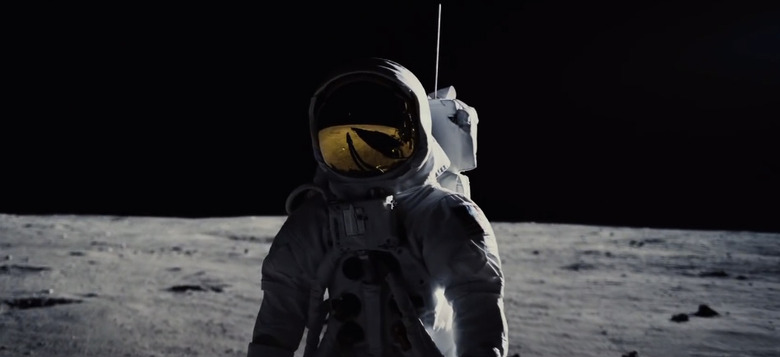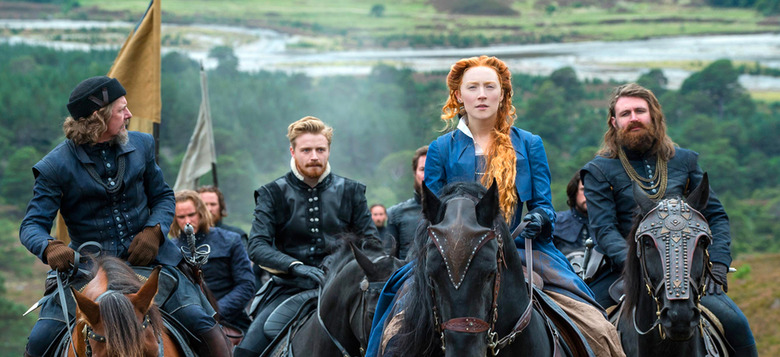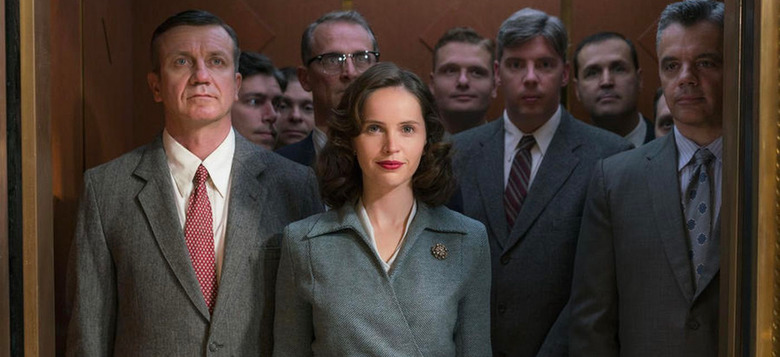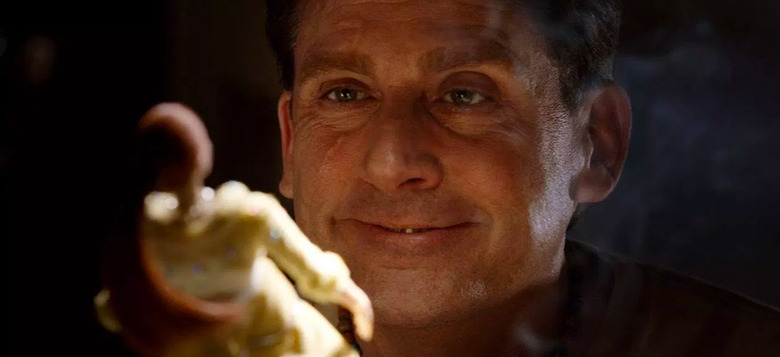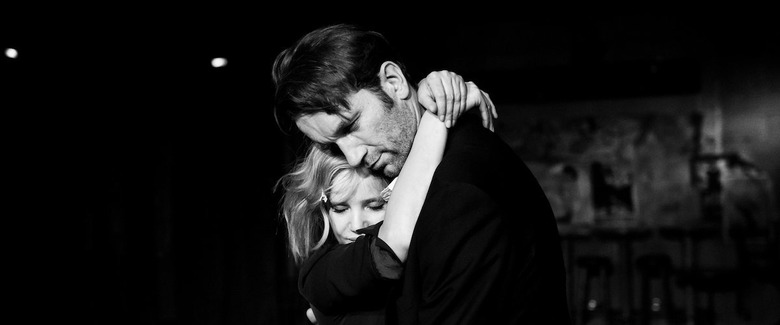The Cinematographers Behind 'Cold War,' 'First Man' And More Share Stories Of Their Craft
As we head into the final stretch of awards season, /Film had the opportunity to speak with a number of cinematographers about their craft. These include Linus Sandgren of First Man, Lukasz Zal of Cold War, John Mathieson of Mary Queen of Scots, Michael Grady of On the Basis of Sex, and C. Kim Miles of Welcome to Marwen. Although not all of these artists were nominated for an Oscar for their work this year, this series of interviews could not be more timely. With this year's ceremony removing the cinematography award from the live broadcast (and airing the acceptance speeches later in the show), it is more important than ever to take notice of the craft that goes into lighting and shooting a movie.
Linus Sandgren – First Man
When it comes to shooting First Man, what was the most challenging aspect of the shoot?I think the most challenging was that the film was meant to feel almost effortless, real and documentary, as if one cameraman just followed these people around in the '60s. Could be easy in a normal situation, but in environments which are obviously not real it is really hard, especially since we took on a path where we decided to capture the final image as much as possible in camera, and not use any green screen for example.In all this technical focus, we had to stay faithful to the needs of the story, so we made sure to put the technical aspects aside and discover the language of the film.We wanted to approach the photography with realism, and follow the emotions of the story with a careful hand. Find poetry through metaphors of death and grief. Make it feel both tender, intimate at times, scary, visceral and immersive other times and epic, as well.It took a lot of research and puzzle work with many departments full time collaborating to get to where we got. For example did we need to develop a Lamp, 2x the power output of the brightest one existing at the time, in order to cover the set we built for the moon scenes with the right exposure. This lamp is a 200,000W single source lamp. We also had to figure out many different type of solutions for each scene to trick the audience in believing we were traveling in space or up in an elevator along the Saturn V rocket. It included very modern LED rear screen solutions on stage as well as practical vehicle to vehicle solutions on location, but also miniature photography, etc.When it came to shooting the lunar landing, was there anything in particular that Damien Chazelle wanted for the scene?The transition from the Capsule to the Moon Surface was a very important moment for Damien. Damien wanted it to feel emotionally intimate and alive, throughout the film until we exited the human world, into the surreal and serene beautiful but sterile moonscape. He wanted it to contrast as much as it does in the Wizard of Oz, stepping out from black and white to Color.The World out there is silent, its bare and dead. Neil can finally accomplish not just his human achievement, but also his personal achievement and finally come to rest with his grief. Here, Damien wanted the first POV to belong to the Audience, and in this environment he wanted us to both feel as if you are there for real, but its also time for afterthought. Perhaps to connect with your own ghosts. We were looking for another type of Poetry, to connect with the audience in a different way, so it was important to change as much as possible visually, but still stay in the movie.So we basically go from gritty, noisy, shaky space capsule, 3rd person hand held documentary 16mm, something we can relate to, and ideally be immersed in a real way, to 1st person POV and when outside the astronaut, the space mans helmet is faceless. We have a floaty camera, clean, dead landscape, IMAX (with a huge difference in grain and resolution), silence, poetic score in minor keys, which all hopefully makes the audience feel emotionally connected in a different way.As a DP, how have your techniques improved over the years?Of course you learn on each project about different techniques and with growing experience both on commercials and feature films, you get a wider knowledge of ways to achieve imagery, but to me, the meaning of Cinematography is toVisually tell the Story and especially to help convey the Emotions in the Story. I try to always start with a fresh mind, and work with the Directors Vision, help develop the visual language, and any technical aspect is just based on decisions made from this work. The script, the vision, the locations, all determine the techniques.So for example, First Man was hand held because that particular story asked for it. We also shot on mixed film formats, because we felt more grain helped us to connect with the human story as well as the visceral claustrophobic space travel, while IMAX helped us to take in the beauty of the serene moon, and acted as a dramatic contrast, going from intimate human 16mm to surreal Moonscape in IMAX.Is there a particular camera that you like to use?I generally prefer film cameras, because the way it captures the images is different from how a digital camera captures the images. And with film cameras I personally can give myself many more options and a lot more control on the images while I am shooting.But I always try to be open to any format, and base it on the story and how it wants to be expressed, I just always tend to return to film as my first choice. But for example, on the Hundred foot Journey, I shoot the majority of the story on 35mm anamorphic and push processed 1/2 a stop to bring out the most of colour and contrast in the food and the French countryside, to make it feel romantic and enchanting, while when the main character leaves this idyllic world to make a career in Paris, he looses track of his grounded self, and gets emotionally colder, so we wanted the world around him to feel more sterile, and we shot that Paris sequence on the same lenses but with Digital cameras, and you can see a clear difference in life.And that is how I like to use formats, let the story and the emotions guide you.With winning an Oscar for La La Land and being named as DP for the next Bond film, how do you manage to stay grounded?[Laughs] Well, its obviously flattering to be recognized and for brief moments you get to walk on clouds, and I am very grateful for the film project opportunities I am given. But what I am most glad about and proud for, is the work itself. I love making movies, because it's a collaborative creative and often challenging process, where you work hard, together with a large group of grounded, real people. When I come home, I have my lovely family to come home to, and all these people around me are all very grounded.
John Mathieson – Mary Queen of Scots
How does shooting a film like Mary Queen of Scots differ from something like Logan?Mary Queen of Scots was a very ordered studio affair shot in Pinewood Studios and various stately Medieval homes up and down the country. Outside the floor work, rehearsing and blocking; much time was spent on detail, getting the artists into complex costume and make up and set dressing and general frothing. The shooting also was quite ridged as a large amount of screen time was spent in the respective courts of the two Queens. So your compositions are symmetrical and arranged with your Queen central and the various Dukes, Lords, Ambassadors around her and the lesser parliament figures on the edges of frame. Theatrical if you will. If Ma'am stands we all stand, if she takes her thrown you may sit, if you address the Regent you stand and so on. That is a Royal Court.Logan well, there weren't no Royalty or castles; we were on the road on the run. So it was asymmetric, left foot and grubby.What was the most challenging aspect of the shoot?Trying to get out and give the film some epic sweep. These two women ruled countries and made armies go to war over them, and Mary faced and incited rebellion several times. We did our best with the budget and locations we had. I would have liked to have seen more of and understood the worlds they lived in. However the script was more geared to the goings in the two courts the Queens found themselves in.How do you feel that your techniques have changed over the years as a director of photography?Well for one, it's a hell of a lot easier with these digital cameras. We wanted to shoot Mary Queen of Scots on film, but that was not to be. You really don't have to be as good as craftsman you used to be. You can see instantly what you have done which is not always a good thing. Individual styles are lost or watered down with digital; you are not working in stone. I miss film and the discipline that came with it. After Mary Queen of Scots, I was invited to shoot Detective Pikachu on film, by the Director and the VFX Supervisor and oddly enough by the producers. It looks terrific.
Michael Grady – On the Basis of Sex
One of the things that hit me early in watching On the Basis of Sex was the decision to slowly point out Ruth Bader Ginsburg in a sea of men. What went into shooting this particular scene and were there other moments that you felt like slowly panning onto Justice Ginsburg or other women in the room?Well, early in the film we wanted to establish this sense of a singular female attempting to survive or even thrive in a sea of men–metaphorically and physically. We really went out of way to create these images of her amongst men. The first scene attempts to even abstract elements of men and women. Groupings of young Harvard law students marching in slow motion to the Harvard Fight Song. Amongst hundreds of men in suits emerges one woman in each shot. Ruth Bader Ginsberg swimming upstream dodging men.....We tried to literally frame as many men around her as possible. The opening scene was actually a few hundred men in suits swarming that singular beautiful blue dress. We also tried to visually connect her to the other women who were attempting to defy the odds and graduate from Harvard Law School at the time. Throughout the film, We continued to create images of her surrounded by men in in the workplace, Washington, and ultimately.... in court.What was the most challenging aspect of the shoot?Well, period movies are always tough. We try so hard to create a reality of the past. In this case a New York city that has long transformed into nonexistence. Old Montreal serves as a wonderful facsimile of a New York past. It is always difficult to control the palette in period movies and attempt control all that we see in the frame that not only are period specific, but also are the correct elements to tell our story. I hope we pulled it off.How do you feel that your techniques have changed over the years as a director of photography?I have change quite a bit. My slow transformation from film into the digital age has altered my approach to lighting. I hope my work both feels natural but also more specific in some emotional way. I feel like I am more responsive to the script and I hope that I am allowing the script to always inform my work. I hope that my work has matured enough to even disappear at times. Here, I tried to shoot in a style that echoed the films of these periods that our story took place. I hope I approached things on a level not unlike cinematographers of these eras. Reserved and composed....Like Justice Ginsberg.
C. Kim Miles – Welcome to Marwen
How does DPing Welcome to Marwen differ from that of a TV series like Arrow or The Flash?The experience of shooting "Marwen" with Robert Zemeckis was one filled above all with collaborative respect. Bob's body of work over the years has inspired my own for my entire career; to get to work with him one-on-one was something of which I'd never dreamed. I'm forever humbled that he elected to entrust in me the visual representation of this story, and in doing so gave me collaborative ownership of the picture of which I'm so very proud. I've spent my entire career, especially on Warner Bros.' "Arrow" and "Flash" trying to emulate Bob's storytelling finesse in shot design and camera movement; "How would Robert Zemeckis tell this story point?" is often in my head. To be approached by the man himself out of the blue was a fairytale come true.The process of shooting a feature differs from shooting episodic television in that each takes a different approach to a common goal; telling the story, and each approach brings its own shortfalls to the table that need to be addressed differently. In a television season, one has an abundance of screen time during which to develop characters and drive story arc; six episodes, ten, sometimes as many as twenty-three in a season. This allows the writers the opportunity to craft their story carefully over an extended period of time. However, delivering the twenty-three episodes necessary to tell the story within the allocated time forces a disciplined economy of filmmaking that emphasizes quantity of footage (be it with multiple cameras or long shooting days) to fill editorial bins with enough padded coverage to allow for Producer, Studio and Network cuts of the episodes that can occasionally differ from the original vision of the director of each episode. This quantity – based approach satisfies the Network-centric decision making process to which television must adhere, but precludes out of necessity the ability to take the time and resources to finely craft each shot to perfection.A feature film is not without its challenges either; its biggest rival is also time, although the time it battles is not on set but on the screen itself. With between ninety and a hundred and thirty minutes to build story arc, economy of storytelling itself is paramount. Therefore the challenge is to apply economy to the story itself so as to allow its telling to be realized to its full potential. While one has much more time on a feature set to craft each moment in the film to perfection and exactly realize the director's vision of it, those moments absolutely MUST be perfect because not one can be wasted lest it fail to propel the story. Our focus is therefore on quality above all else.Therefore, I'd say that the main difference between shooting episodic television and a feature like "Marwen" lies in the direction in which the production's efforts are focused; on television, to acquire ample footage to serve potentially differing interpretations of a large novel, or in a feature, to tune to perfection each precious moment of a short story that can bear nothing but singularity of storytelling purpose.What was the most challenging aspect of the shoot?I initially imagined that the most challenging aspect of shooting "Welcome to Marwen" with Robert Zemeckis would be to keep from feeling intimidated by the sheer presence of Bob himself and all the cinematic significance that his work represents. Living up to the previous successes of his collaboration with Don Burgess was a heavy prospect indeed.As it turns out, Don's assertion to me that Bob had hired me to shoot his movie and wanted my collaboration was absolutely accurate. Bob expected the cameraman he'd hired to do the job and collaborate to propel the story forward with judgement worthy of his trust. Once I felt I'd earned that trust, making the movie became a daily exercise in anticipating problems before they arose and dealing efficiently with those that we hadn't, no different from any movie.Which left what became the real challenge of the show; collaborating with Kevin Baillie and his Visual Effects crew to best interpret, capture and build the 1/6-scale world of the Dolls through which our main character, Mark Hogancamp, heals. In order to conquer the "Uncanny Valley" in which audiences instinctively mistrust fully-CG characters, Bob and Kevin's (and therefore my) goal became to represent these digital Doll characters in a way that would allow audiences to connect to them emotionally. Bob and Kevin's notion that the secret lay in the representation of the dolls' eyes (the "windows to the soul") proved to be exactly the key to the problem.This resolution however now meant that we'd have to photograph the cast acting each part of each scene out so that their faces could be infused into the digital characters. How would we do this? As a facial-array capture during which each cast member would have the merciless task of acting each scene out whilst confined to a locked head position? Or was there another solution? How about photographing their faces as the cast acted scenes out during the motion-capture phase that we knew VFX would need from which to draw their characters' bodily movements? If we used this approach, would we light everything flat and even and allow VFX to shape lighting on the characters' faces in post production, or should we light each scene as though it was real and therefore most accurately create alighting environment in which the actors could perform? Testing proved thrust the latter was the answer, which led to the next step; how to determine how to light each scene. The answer came in the form of a previsualisation process on steroids. Profile Studios, our motion capture supplier, would build each virtual set using the "Unreal" video game engine. Bob and I would virtually enter these "worlds" through the lens of a virtual camera and determine primary shooting angles for each scene, complete with optimal character placement for lighting and storytelling. I would then sit with Ryan from Profile and "light" each scene with virtual lights drawn from data acquired from our stable of physical lighting equipment.With those lighting strategies "virtually" locked down, we then used that data to physically light the motion capture volume to match key and fill lighting direction and quality so that the faces of the actors would interact with the light as though they were actually in a real set. This way when Kevin Baillie and his gang at Atomic Fiction/Method built their virtual worlds in which to place the characters, they'd have not only accurate lighting reference for each environment, but each character's face would also be lit correctly for all their action, making the blending of the two worlds more seamless. I think they did an outlandishly great job and the result is simply stunning and something that folks won't have ever seen before.How do you feel that your techniques have changed over the years as a director of photography?I would say that my photographic techniques have matured over the years, in a way not unlike how my life has matured. I see the big picture a lot more clearly now; I try to bring a movie together as a whole instead of a sum of its parts. I no longer sweat the little things. A big revelation I had recently was to stop striving to banish imperfection from my photography, that it's actually imperfection that makes us human, and that brings surprise and magic into life. Embracing it breathes life into my photography in a way that I really enjoy.Movies are a mechanism by which one can escape from one's own realities, even for just a moment; to find some joy or hope in a bleak time, to be inspired to pick oneself up from rock bottom, or simply to be distracted from the pain. They can inspire growth and make people rise to a challenge. Being entrusted to create such a precious resource is an honour and a privilege. Being entrusted to do so with a lifelong inspiration like Robert Zemeckis is an opportunity beyond words.As a boy growing up in Malaysia, storytellers like Robert Zemeckis inspired me to believe that maybe, just maybe, there was room in Hollywood for me. Now, here I am, having just worked with the man who's inspired me my whole life. My job going forward is to help the next generation rise. There's always room at the table for a good idea, a fresh outlook and a willingness to work hard. If I could do it, anyone can.
Lukasz Zal – Cold War
What was the most challenging aspect of shooting Cold War?Everything was pretty challenging but in a very good way. In general, I think that is the most challenging aspect was to shoot another black and white film and with the same aspect ratio but shooting in a different way. I think I was afraid of the models. Maybe not afraid but we didn't want to repeat ourselves so that is why we spent a lot of time just looking for solutions how to shoot the film completely different and not to repeat ourselves and find a different way in the same format and also often using a fixed camera but use all those tools in a completely different way and just shoot the film very different. I think that was the most the most challenging thing just to apply a different way. Different tools and also make the film and all those cinematographic tools that are working for this story. They are telling the story and are helping the story. They are making this more emotional and they are conveying some emotions and the world and the film is changing in style. In the beginning, a documentary but later on changes into something more highly stylized (inaudible) Ida. And when Zula appears, she's very emotional. The camera is just following them and her and she triggers the camera. At the end up after the parish which is very applicated and that could drop just to be here in Poland, which are dedicating a kind of a part of the landscape—there is a lot of it in the film. I think that was very challenging but also it's very challenging to just to be open for what the film yells to you to be all the time serving the film, what its giving to you and try not to make this what we do with preferred area but be all the time open for this—what the film is giving and to be open for the story, to be open for what is happening between our characters. That was a pleasure and a pure joy to work like this—to work a little bit maybe not a documentary but we were preparing with Pawel for a long time.While we were very upset, we were open—we were just placing the camera and literally scouting the images, changing the frame. It was really like refining the picture all the time and Pawel was working like this that while he's handling all the elements like actors (stars, extras) and all this field work, he's using a lot of faith trying to try to capture this magical moment and that was kind of a challenge just every day never give up and every day be very aware and open for this what can happen in front of the camera for this somehow cinematographic magic and just everyday be very strong and having a lot of world that just allows ourselves to be in this process and never give up so I think that was very challenging but it's amazing.Also, I think the challenge was to just capture this emotional story—to capture what's behind our characters and to find the best tools to tell it. Of course, there was also a lot of technical stuff which was really hard and not easy and much harder than Ida. I think much harder than the previous things that I was doing because there was a much bigger screen and a lot of post-production of a green screen. Maybe you can't see it but it was really a lot of Pawel's techniques in this film. So I think that this film was very complicated at every level and also a post-production that was very complicated because when you have a scene which is one minute and a half and have a big window, which is half of the screen, it's not so easy to create the reality behind the window.Like in Paris, which is not just the information that we're in Paris, but it's very detailed and there is something. Every scene is like a little story. We put so much energy and a fourth to every single shot just because when you're shooting film like this, everything must be kind of perfect and everything just can't be like a scene but it must be always something and that's what I think was the most challenging for Pawel and for me, too.

